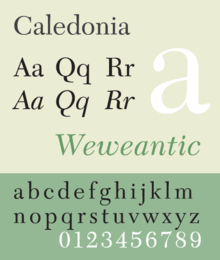- Caledonia (typeface)
-

Category Serif Classification Transitional serif Designer(s) William Addison Dwiggins Foundry Mergenthaler Linotype Company Date released 1938 Design based on Scotch Roman + Bulmer Also known as Cornelia Caledonia is a transitional serif typeface designed by William Addison Dwiggins in 1938 for the Mergenthaler Linotype Company.
Dwiggins chose the name Caledonia, the Roman name for Scotland, to express the face's basis on the early nineteenth century Scotch Roman typeface however, though Dwiggins began with the thought of copying the classical Scotch Romans, eventually he drew more inspiration from the Bulmer design of William Martin.[1] The face has a more vertical stress than an old style garalde faces, with mostly unbracketed horizontal serifs. The G is open and the R has a curved tail. the t is unbracketed. Italic characters p and q have no foot serif. The character set, as drawn by Dwiggins was wide, including ranging (old style) figures, lining figures, and small capitals in the text and bold weights. A Greek version of the face is available. Caledonia ranks with Times New Roman as one of the most used book text faces.
Contents
Hot Metal Type
Machine Composition
Caledonia made initially for machine composition with foundry type only made later, and then only in Germany. The following variants were designed by Dwiggins and released by Linotype:
- Caledonia + Italic (1938)
- Caledonia Bold + Bold Italic (1940)
Linotype also made 36 point matrices for Caledonia Bold Condensed, but it is doubtful that Dwiggins had anything to do with their design. The face was sold by Linotype in England under the same name, and in Germany as Cornelia.[2]
Foundry Type
Cornelia, as it was called there, proved so popular in Germany, that the Stempel Foundry cast is as foundry type.[3]
Cold Type Copies
Caledonia’s popularity as a text face continued right through the cold type era, and it was sold then under the following names:[4]
- Caledonia — Mergenthaler, Monotype
- Caledo — Alphatype
- Highland — Autologic, Dymo, Star/Photon, Varityper
- Balmoral — Autologic, Berthold, Harris, , Varityper.
- California — Compugraphic
- CaledonStar — Star/Photon
- Edinburgh — Graphic Systems Inc.
- Laurel — Harris, MGD Graphic Systems
- Calderon — Scangraphic
- Gael — Information International Inc.
Digital Copies
A digital version, called New Caledonia, available in four weights: text, semibold, bold, and black, each with small capitals, was released in 1982. Digital copies are made by Adobe and Linotype.
References
- Blackwell, Lewis. 20th Century Type. Yale University Press: 2004. ISBN 0-300-10073-6.
- Bringhurst, Robert. The Elements of Typographic Style. Hartley & Marks: 1992. ISBN 0-88179-033-8.
- Fiedl, Frederich, Nicholas Ott and Bernard Stein. Typography: An Encyclopedic Survey of Type Design and Techniques Through History. Black Dog & Leventhal: 1998. ISBN 1-57912-023-7.
- Macmillan, Neil. An A–Z of Type Designers. Yale University Press: 2006. ISBN 0-300-11151-7.
- ^ Hlasta, Stanley C., Printing Types & How to Use Them, Carnegie Press, Pittsburgh, PA, 1950, pp. 111-114.
- ^ MacGrew, Mac, American Metal Typefaces of the Twentieth Century, Oak Knoll Books, New Castle Delaware, 1993, ISBN 0-938768-34-4, pp. 56 + 57.
- ^ Jaspert, W. Pincus, W. Turner Berry and A.F. Johnson, The Encyclopedia of Type Faces, Blandford Press Lts., 1983, ISBN 0-7137-1347-X, p. 34.
- ^ Wheatley, W.F., Typeface Analogue, National Composition Association, Arlington, Virginia, 1988, p. 7 + Lawson, Alexander, Archie Provan, and Frank Romano, Primer of Typeface Identification, National Composition Association, Arlington, Virginia, 1976, pp. 34 - 35.
External links
Categories:- Linotype typefaces
- Transitional serif typefaces
- Letterpress typefaces
- Photocomposition typefaces
- Virtual typefaces
Wikimedia Foundation. 2010.
